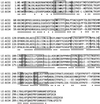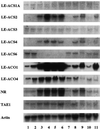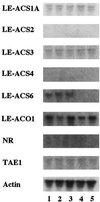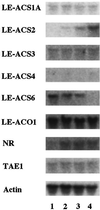Differential expression and internal feedback regulation of 1-aminocyclopropane-1-carboxylate synthase, 1-aminocyclopropane-1-carboxylate oxidase, and ethylene receptor genes in tomato fruit during development and ripening
- PMID: 9847103
- PMCID: PMC34745
- DOI: 10.1104/pp.118.4.1295
Differential expression and internal feedback regulation of 1-aminocyclopropane-1-carboxylate synthase, 1-aminocyclopropane-1-carboxylate oxidase, and ethylene receptor genes in tomato fruit during development and ripening
Abstract
We investigated the feedback regulation of ethylene biosynthesis in tomato (Lycopersicon esculentum) fruit with respect to the transition from system 1 to system 2 ethylene production. The abundance of LE-ACS2, LE-ACS4, and NR mRNAs increased in the ripening fruit concomitant with a burst in ethylene production. These increases in mRNAs with ripening were prevented to a large extent by treatment with 1-methylcyclopropene (MCP), an ethylene action inhibitor. Transcripts for the LE-ACS6 gene, which accumulated in preclimacteric fruit but not in untreated ripening fruit, did accumulate in ripening fruit treated with MCP. Treatment of young fruit with propylene prevented the accumulation of transcripts for this gene. LE-ACS1A, LE-ACS3, and TAE1 genes were expressed constitutively in the fruit throughout development and ripening irrespective of whether the fruit was treated with MCP or propylene. The transcripts for LE-ACO1 and LE-ACO4 genes already existed in preclimacteric fruit and increased greatly when ripening commenced. These increases in LE-ACO mRNA with ripening were also prevented by treatment with MCP. The results suggest that in tomato fruit the preclimacteric system 1 ethylene is possibly mediated via constitutively expressed LE-ACS1A and LE-ACS3 and negatively feedback-regulated LE-ACS6 genes with preexisting LE-ACO1 and LE-ACO4 mRNAs. At the onset of the climacteric stage, it shifts to system 2 ethylene, with a large accumulation of LE-ACS2, LE-ACS4, LE-ACO1, and LE-ACO4 mRNAs as a result of a positive feedback regulation. This transition from system 1 to system 2 ethylene production might be related to the accumulated level of NR mRNA.
Figures






Similar articles
-
Expression and internal feedback regulation of ACC synthase and ACC oxidase genes in ripening tomato fruit.Plant Cell Physiol. 1997 Oct;38(10):1103-10. doi: 10.1093/oxfordjournals.pcp.a029094. Plant Cell Physiol. 1997. PMID: 9399434
-
The regulation mode of RIN transcription factor involved in ethylene biosynthesis in tomato fruit.J Sci Food Agric. 2011 Aug 15;91(10):1822-8. doi: 10.1002/jsfa.4390. Epub 2011 Apr 26. J Sci Food Agric. 2011. PMID: 21520447
-
Differential induction of seven 1-aminocyclopropane-1-carboxylate synthase genes by elicitor in suspension cultures of tomato (Lycopersicon esculentum).Plant Mol Biol. 1997 May;34(2):275-86. doi: 10.1023/a:1005800511372. Plant Mol Biol. 1997. PMID: 9207843
-
Ethylene biosynthesis and action in tomato: a model for climacteric fruit ripening.J Exp Bot. 2002 Oct;53(377):2039-55. doi: 10.1093/jxb/erf072. J Exp Bot. 2002. PMID: 12324528 Review.
-
Control of ethylene-mediated processes in tomato at the level of receptors.J Exp Bot. 2002 Oct;53(377):2057-63. doi: 10.1093/jxb/erf062. J Exp Bot. 2002. PMID: 12324529 Review.
Cited by
-
Comprehensive RNA-Seq Analysis on the Regulation of Tomato Ripening by Exogenous Auxin.PLoS One. 2016 May 26;11(5):e0156453. doi: 10.1371/journal.pone.0156453. eCollection 2016. PLoS One. 2016. PMID: 27228127 Free PMC article.
-
Identification and Comparative Analysis of Differential Gene Expression in Soybean Leaf Tissue under Drought and Flooding Stress Revealed by RNA-Seq.Front Plant Sci. 2016 Jul 19;7:1044. doi: 10.3389/fpls.2016.01044. eCollection 2016. Front Plant Sci. 2016. PMID: 27486466 Free PMC article.
-
Ethylene Signaling under Stressful Environments: Analyzing Collaborative Knowledge.Plants (Basel). 2022 Aug 25;11(17):2211. doi: 10.3390/plants11172211. Plants (Basel). 2022. PMID: 36079592 Free PMC article. Review.
-
Regulatory role of cystathionine-gamma-synthase and de novo synthesis of methionine in ethylene production during tomato fruit ripening.Plant Mol Biol. 2006 May;61(1-2):255-68. doi: 10.1007/s11103-006-0009-8. Plant Mol Biol. 2006. PMID: 16786305
-
Expression of ripening-related genes in prickly pear (Opuntia sp.) fruits.Plant Foods Hum Nutr. 2003;58(4):317-26. doi: 10.1023/b:qual.0000040286.28359.76. Plant Foods Hum Nutr. 2003. PMID: 15354791
References
-
- Akamine EK, Goo T. Respiration and ethylene production in mammee apple (Mammea americana L.) J Am Soc Hortic Sci. 1978;103:308–310.
-
- Barry CS, Blume B, Bouzayen M, Cooper W, Hamilton AJ, Grierson D. Differential expression of the 1aminocyclopropane-1-carboxylate oxidase gene family of tomato. Plant J. 1996;9:525–535. - PubMed
-
- Biale JB, Young RE. Respiration and ripening in fruits—retrospect and prospect. In: Friend J, Rhodes MJC, editors. Recent Advances in the Biochemistry of Fruits and Vegetables. London: Academic Press; 1981. pp. 1–39.
-
- Chang C, Kwok SF, Bleeker AB, Meyerowitz EM. Arabidopsis ethylene-response gene ETR1: similarity of product to two-component regulators. Science. 1993;262:539–544. - PubMed
-
- Fluhr R, Mattoo AK. Ethylene—biosynthesis and perception. CRC Crit Rev Plant Sci. 1996;15:479–523.
Publication types
MeSH terms
Substances
Associated data
- Actions
- Actions
LinkOut - more resources
Full Text Sources
Other Literature Sources
Miscellaneous

